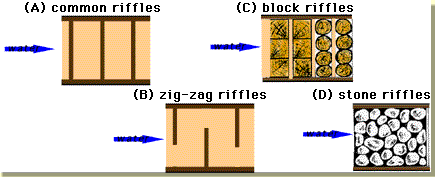![]()
![]()
![]()
![]()

(A) Common riffles are merely pieces of wood
extending from one side of the trough to the other. These
form obstructions which impede and collect the gold. Common
riffles vary in size, depending upon whether they are used
in a rocker, Tom, sluice or dredge.

(B) Zig-zag riffles are similar to common riffles, except that they do not extend all the way across the trough. Instead, the alternate ends are open, forcing the water to swing around them like the curves of a stream. Some pioneer prospectors swore by this type of riffle, claiming that it was the most efficient for recovering the finest values.
(C) Block riffles are used when there are a lot of pebbles and boulders in the gravel being washed. These rocks tend to wear down normal riffles far too rapidly, so block riffles, which last much longer, are substituted. These are wooden blocks eight to 13 inches deep, cut across the grain, and placed upright in rows across the sluice. Each row is separated by a space of one to two inches, and kept in place by riffle strips. Square block riffles are the best for saving gold, although sections of wood are frequently used just as they are sawn from the round log. Whichever is used, these riffles offer a further advantage of trapping the finest gold within the grain. The miners of old, upon the block riffles wearing out, would burn them and pan the ashes.
(D) Stone riffles are used to the best advantage where heavy, strong cemented-gravel is being washed. The rocks are naturally of an irregular shape and size, and are set in the sluice with a slight tilt downstream. Rock riffles are cheap and extremely durable, but have the disadvantage of being more awkward and costly to handle, requiring a longer time to clean up and repave the sluice. They also require steeper grades and more water..
 Build your own sluice!
Build your own sluice!
|
Last updated November 30, 1998. |


